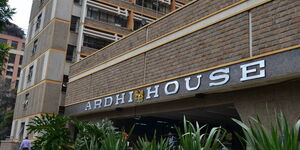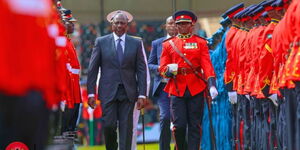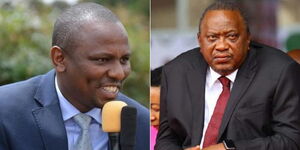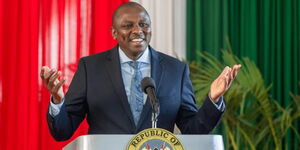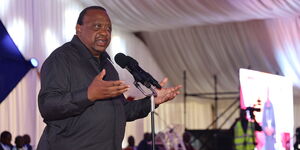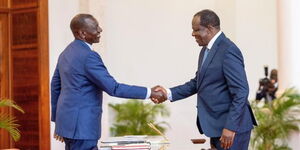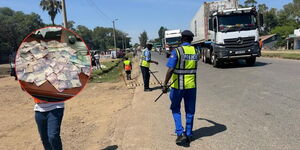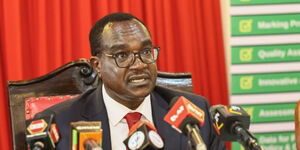The corruption menace in Kenya is well documented even as President Uhuru Kenyatta at one point termed it as the country's biggest threat and enemy.
However, the real origins of the vice are hidden away in historical anecdotes, and books authored by brave individuals who dared to challenge the system.
Former Bahari Constituency legislator Joe Khamisi is one such individual. In his 2018 book Looters and Grabbers: 54 Years of Corruption and Plunder by the Elite, 1963–2017, he details how Chiefs during the colonial era engineered the blueprints of bribery in Kenya, passing it down from generation to generation.
At the time (pre-independence), the colonial masters appointed Chiefs to perform a myriad of work, but they did not allocate funds for their remuneration.
This forced them to use their own money, and to look for 'ways' of supplementing their income. These ranged from grabbing chunks of land for themselves as payment for settling a dispute, to demanding for money.
Things got worse when the British colonial administration enacted the Chief’s Act in 1937, when they were given more powers, including maintaining law and order, collecting taxes to help sustain the luxurious lifestyles of white settlers, overseeing agricultural activities in their areas, and mediating disputes.
They habitually confiscated livestock from tax defaulters to swell their herds, and accumulated land that really belonged to other people.
It was routine for chiefs to raid a village and demand surrender of personal property under threats of arrest. They collected hut and poll taxes and retained part of the money. In 1912, the salary of chiefs was Ksh3,413 per year.
Chiefs exerted themselves to please the authorities, often taking actions that turned out to be an abuse of rights. They sometimes beat and tortured innocent villagers to demonstrate their commitment to duty and loyalty to their masters.
This is how they accumulated wealth over the years and started what is now referred as the elite class or dynasties.
Elijah Waicanguru, who started as a headman in Ihithe sub-location in Nyeri district and later became a Judge of a tribunal in Tetu, was one of the first Africans to own a car, a Chevrolet pick-up truck in 1946.
Musa Nyandusi (Simeon Nyachae's father), a former wrestler known for his strength and quickness” became one of the wealthiest Africans in the whole of Nyanza Province.
Kinyanjui wa Githirimu of Dagoretti who rose from a potter to a paramount chief as a reward for helping the British take Gikuyu land was rewarded with a large parcel of land, a large herd of cattle, and had no less than 100 wives.
Loyalty rather than competence was the yardstick for elevation. The more one was able to carry out British interests, the more likely they would be promoted to paramount chiefs.
These included the likes of Waruhiu wa Kung’u of Githunguri and Waiyaki wa Hinga of Kikuyu, Chief Josiah Njonjo of Kabete, Muhoho wa Gatheca of Kiambu, Koinange wa Mbiyu of Kiambaa, Koitalel arap Samoei of Nandi, Owuor Kere of Nyakach, Ole Murumbi of Maasailand, and chief Ouuduu of Nyanza.
Chief Waruhiu was reputed as “an excellent labor recruiter,” but he was also said to have been corrupt and solicited for bribes from litigants in local tribunals.
He became very wealthy. However, his extreme loyalty to the colonialists were to become his undoing. On October 7, 1952, as he drove home from the Kiambu courthouse where he had been summoned to answer to a land-related charge, Waruhiu was shot dead by killers who escaped in a car, never to be found.
It can be argued that the manipulation of tribal chiefs formed the roots of today’s African elite class.
From their lineage of the pioneer chiefs came people like Charles Njonjo, the ebullient barrister and attorney general; Simeon Nyachae, the buoyant former Head of the Kenya Civil Service; Mama Ngina Kenyatta, wife of the founding father; Mbiyu Koinange, Kenyatta’s right hand man, and others.
Senior Chief Koinange wa Mbiyu became chief in 1938 and retired in 1949. Mzee Jomo's third wife, Grace Wanjiku, was Koinange's daughter.
His son, Peter Mbiyu Koinange (nicknamed Kissinger) was a powerful Minister of State in the Office of the President. He was also Kenyatta’s bosom buddy, in-law, confidant and political go-between. He died in 1981 leaving behind a Ksh14bn estate.
His other son, Charles Karuga Koinange took over in 1951 as Chief of Kiambaa, rose to DC and later PC in Central and Eastern provinces. When he died in 2004, he left behind a Ksh5bn estate that was the source of many court battles.

